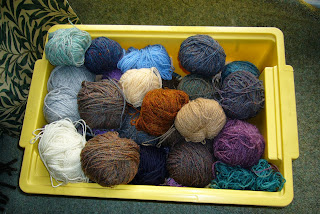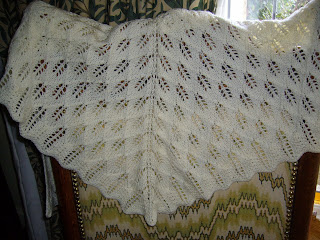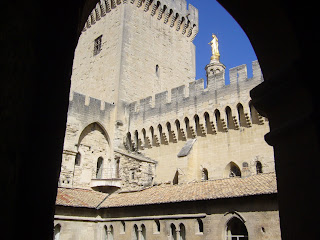Reading Jean and Kristie's posts about their trip to Shetland sets me thinking. Jamieson and Smith. How much this name has meant to me over the years.
I first came across their yarn in Whitby, in a wonderful shop called "The Shepherd's Purse". They had the full spectrum of 2ply jumper weight hanging on a line across the shop - a glorious sight. You could buy yarn there or you could order it by mail. It took me a while to realise that it was possible to order direct from Lerwick. I bought some bright tones of purples and used a cone of navy to make a cheery striped pullover. This would have been about 1980.
Then I discovered Sasha Kagan. Her designs used the 2ply jumper weight alongside touches of lurex and mohair. Now, Sasha's designs tend to feature flowers and leaves, but in her first book - "The Sasha Kagan Seater Book" - variety was key - lots of dynamic movement in the placing of images. I knitted two of the Ribbons cardigan, buying the yarn from the Art Needlework shop in Oxford. This was by far the most successful colourway.
Then I knitted Pansies. This had bands of white mohair and silver lurex.
For myself I knitted a very striking waistcoat with dachshunds running up and down on it. It was backed with three colours of brown used alternately in a ribbed fabric. I was very fond of it but eventually it no longer fitted.
This is the image from the book, as I sent my waistcoat to the collection of the Knitter's guild.
Making these projects made me see how inevitably a stock of spare yarn is built up. When I knitted this Kaffe Fassett waistcoat for my younger sister, I bought in only a few new yarns. Similarly when I reprised the design for my mother. Using some blues in a brown mix gave it a lift. I inherited this waistcoat when my mother no longer needed it.
This waistcoat from the mid-80s is very much of its time. I had one myself which read "Plus ca change, plus c'est la meme chose", which I was very pleased to find fitted the space without much fudging. For my mother, who lived near the sea, I chose appropriate imagery .
Somewhere in the 90s I remember travelling north on the train with a J&S shadecard. Their yarns were so cheap, and the colours so lovely, that it was a real pleasure to pick out a selection of new yarns. However, when the yarn arrived it was different somehow - the blends a little muddy and the colours in some of them forming slubs rather than blended fibres. It was many years before I used these yarns.
In 2000, we visited Shetland and Orkney just after our wedding. It was at a time when the woolcrop was not in big demand. There was talk of wool being dumped in the sea: we certainly saw someone in Cumbria burning wool in an old quarry. Along the road we saw signs to independent designers and we pulled over to visit. I bought scarves and gloves in wonderful colour combinations. Gloves at £9 a pair - who could knit them for that ? They made great presents. However, J&S itself was a disappointment. The yarns were there, but the patterns on offer were distinctly traditional. So much has changed in the last thirteen years - so many new, young designers, like Kate Davies. I can feel an urge upon me to call up the online shade card and order some yarn.
I first came across their yarn in Whitby, in a wonderful shop called "The Shepherd's Purse". They had the full spectrum of 2ply jumper weight hanging on a line across the shop - a glorious sight. You could buy yarn there or you could order it by mail. It took me a while to realise that it was possible to order direct from Lerwick. I bought some bright tones of purples and used a cone of navy to make a cheery striped pullover. This would have been about 1980.
Then I discovered Sasha Kagan. Her designs used the 2ply jumper weight alongside touches of lurex and mohair. Now, Sasha's designs tend to feature flowers and leaves, but in her first book - "The Sasha Kagan Seater Book" - variety was key - lots of dynamic movement in the placing of images. I knitted two of the Ribbons cardigan, buying the yarn from the Art Needlework shop in Oxford. This was by far the most successful colourway.
Then I knitted Pansies. This had bands of white mohair and silver lurex.
For myself I knitted a very striking waistcoat with dachshunds running up and down on it. It was backed with three colours of brown used alternately in a ribbed fabric. I was very fond of it but eventually it no longer fitted.
Making these projects made me see how inevitably a stock of spare yarn is built up. When I knitted this Kaffe Fassett waistcoat for my younger sister, I bought in only a few new yarns. Similarly when I reprised the design for my mother. Using some blues in a brown mix gave it a lift. I inherited this waistcoat when my mother no longer needed it.
This waistcoat from the mid-80s is very much of its time. I had one myself which read "Plus ca change, plus c'est la meme chose", which I was very pleased to find fitted the space without much fudging. For my mother, who lived near the sea, I chose appropriate imagery .
Somewhere in the 90s I remember travelling north on the train with a J&S shadecard. Their yarns were so cheap, and the colours so lovely, that it was a real pleasure to pick out a selection of new yarns. However, when the yarn arrived it was different somehow - the blends a little muddy and the colours in some of them forming slubs rather than blended fibres. It was many years before I used these yarns.
In 2000, we visited Shetland and Orkney just after our wedding. It was at a time when the woolcrop was not in big demand. There was talk of wool being dumped in the sea: we certainly saw someone in Cumbria burning wool in an old quarry. Along the road we saw signs to independent designers and we pulled over to visit. I bought scarves and gloves in wonderful colour combinations. Gloves at £9 a pair - who could knit them for that ? They made great presents. However, J&S itself was a disappointment. The yarns were there, but the patterns on offer were distinctly traditional. So much has changed in the last thirteen years - so many new, young designers, like Kate Davies. I can feel an urge upon me to call up the online shade card and order some yarn.



































.JPG)